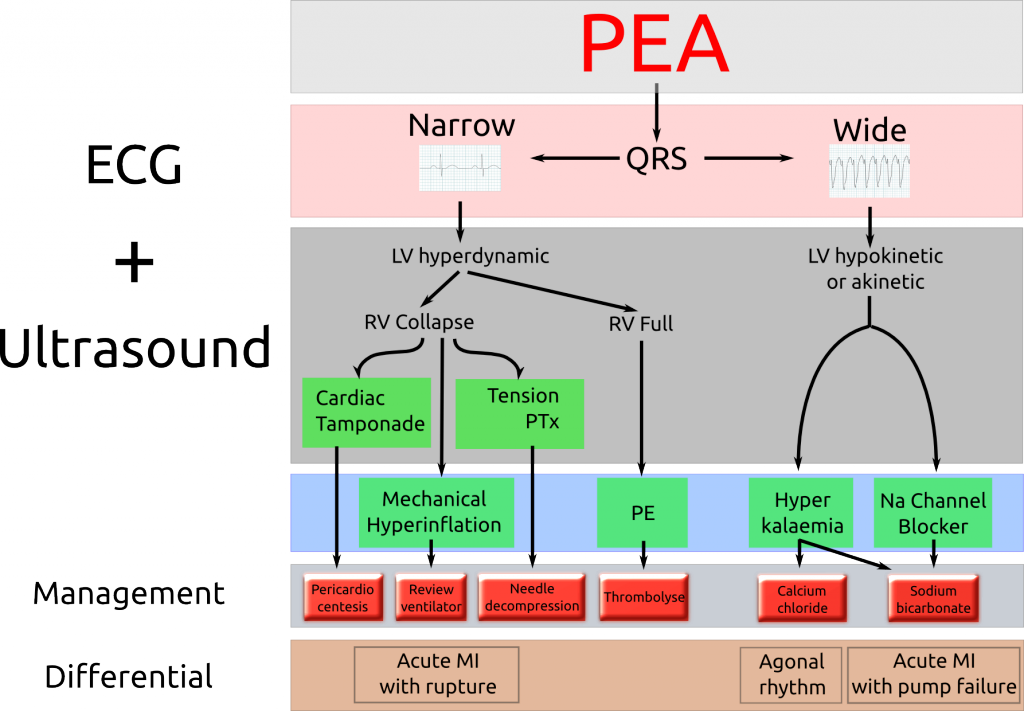ACLS management of PEA arrest is traditionally done using CPR, epinephrine and running through the H’s and T’s. Unfortunately, the H’s and T’s can be difficult to recall in a stressful situation, and furthermore, they do not approach cardiac arrest in a physiologic manner.
We recently reviewed the following paper that uses a novel approach to the management of PEA arrest.
Hypothesis
The authors suggest a revision of the current approach to PEA arrest in order to streamline diagnosis and thus guide resuscitation.
Methods:
The authors reviewed the current evidence around the ACLS guidelines.
Results/Proposed recommendations
Based on the literature review the authors felt cause-specific treatment of PEA arrest is more user friendly than the current ACLS teaching for a number of reasons.
- The current ACLS teaching H’s and T’s of ACLS are cumbersome.
- The current ACLS teaching is difficult to remember in code situation.
- The proposed changes focus on more likely causes of PEA arrest.
- The proposed changes provides a framework to work from.
As a result, the authors proposed the following algorithm to diagnose and manage the most common underlying etiologies of PEA arrest.
Photo courtesy Adelaide Emergency Physicians
Conclusion
The authors felt that their simplified and structured approach offered additional advantages over the current ACLS teachings in three main ways:
- Organized approach using EKG telemetry to differentiate between narrow complex (mechanical cause) vs. wide complex (Metabolic cause) PEA.
- The structured approach reduces the number of possible diagnosis for either wide or narrow QRS morphology.
Wide complex
A wide complex morphology in PEA arrest is likely to be hyperkalemia or sodium channel blocker toxicity.
Narrow complex
Whereas a narrow complex EKG are more likely to be due to PE, cardiac tamponade, tension pneumothorax or hyperinflation. In addition, with narrow complex morphology in PEA arrest, the use of ED ultrasound is likely to further identify the underlying cause.
- The algorithm provides specific treatment recommendations depending on the initial QRS morphology.
- Wide complex
- In the case of a wide complex (metabolic cause) PEA arrest the recommendations suggest IV calcium chloride and sodium bicarbonate depending if the clinical picture is hyperkalemia or sodium channel blockers overdose.
- Narrow complex
- In the case of narrow complex (mechanical cause) PEA arrest the recommendation suggest fluids wide open and using additional ultrasound to help determine if pericardiocentesis, needle decompression, thrombolysis or ventilator management is needed.
Critical Appraisal:
Pro:
- A comprehensive review of current ACLS PEA arrest guidelines
- Common sense approach to PEA arrest
Cons:
- Recommendation only – not a study
- No data to suggest improved outcomes etc.
- Difficult to conduct future RCT to determine effect.
Journal Club Discussion:
There were a number of strengths and weaknesses that came out of the group discussion:
Strengths:
- The recommendations were based on solid review of the current literature/guidelines and most liked the idea of a structured approach to PEA arrest.
- The recommendations focused on the most likely causes of PEA arrest and removed ancillary causes that would appear obvious during assessment (eg. Hypothermia, hypoxia). The group agreed that this provided for a more manageable list to remember as well as a framework for treatment.
- The addition of mechanical hyperinflation as a cause was uniformly agreed as a strong point of the recommendations.
- The additional use of ultrasound was seen as a good step forward in helping to better identify underlying etiology of the PEA arrest.
Weaknesses:
- The absence of trauma, hypokalemia, hypoglycemia, hypothermia, hypoxia and acidosis was a concern for some who felt that there can be subtle presentations that would go un-noticed.
- Generalizable/Staff dependent – Requires ED physicians to be trained in use of ultrasound. (eg. rural areas etc.)
Overall, most journal club participants agreed that the framework was a good idea and helped with recall of important etiology; however, most did say that it would not substantially change their practice as they already use the current model without difficulty or use a modified version of the proposed recommendations.
For more reading on PEA, and whether it actually exists, check out the EDECMO podcast episode #13, here.
Cheers,
Chris

Leave a Reply